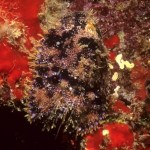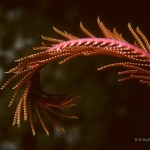Crustaceans
The most incredible eyes in the animal world can be found under the sea, on the head of the mantis shrimps. Each eye can move independently and can focus on object with three different areas, giving the mantis shrimp "trinocular vision". While we see in three colours, they see in twelve, and they can tune individual light-sensitive cells depending on local light levels. They can even see a special type of light - 'circularly polarised light' - that no other animal can.
But Nicholas Roberts from the University of Bristol has found a new twist to the mantis shrimp's eye. It contains a…
Many animals in the sea have evolved colors and forms that allow them to blend in with their surroundings. Some animals use their camouflage to hide from predators -- and some predators use camouflage to fool their prey.
It can be difficult to photograph such animals, partly because it's often hard to find them in the first place. If you look carefully at the photo at right, you will be able to make out the shape of a small purplish slipper lobster (Parribacus antarcticus), right in the center of the photo.
The picture was taken inside an underwater cave in Hawaii, and the lobster was on…
Even the clearest water has at least some particles suspended in it -- sand, silt, plankton, who knows what -- and most of the time, in most places, the water isn't really all that clear. In fact, during a plankton bloom or after a storm that has caused a lot of runoff, you might just as well leave your camera on the boat. Light from a camera strobe has a nasty habit of bouncing back from any particulate matter that it encounters between the camera lens and the subject. The result is the bane of underwater photography: backscatter. Your images will look as though they were taken in a…
In April 1998, an aggressive creature named Tyson smashed through the quarter-inch-thick glass wall of his cell. He was soon subdued by nervous attendants and moved to a more secure facility in Great Yarmouth. Unlike his heavyweight namesake, Tyson was only four inches long. But scientists have recently found that Tyson, like all his kin, can throw one of the fastest and most powerful punches in nature. He was a mantis shrimp.
Mantis shrimps are aggressive relatives of crabs and lobsters and prey upon other animals by crippling them with devastating jabs. Their secret weapons are a pair…
Eagles may be famous for their vision, but the most incredible eyes of any animal belong to the mantis shrimp. Neither mantises nor shrimps, these small, pugilistic invertebrates are already renowned for their amazingly complex vision.
Now, a group of scientists have found that they use a visual system that's never been seen before in another animal, and it allows them to exchange secret messages.
Mantis shrimps are no stranger to world records. They are famous for their powerful forearms, which can throw the fastest punch on the planet. The arm can accelerate through water at up to 10,000…
tags: Charles Darwin, crabs, crustaceans, University of Oxford, Oxford Museum of Natural History, online database
Fiddler crabs are easily recognised by their distinctive asymmetric claws. This specimen was captured in May 1835 when the Beagle arrived in Mauritius.
Image: Oxford University Museum of Natural History [larger view].
The University of Oxford Museum of Natural History has electronically catalogued Charles Darwin's crabs that had been collected by the famous naturalist while he was making his voyage around the world on the HMS Beagle from 1831 to 1836.
These crustaceans were…

